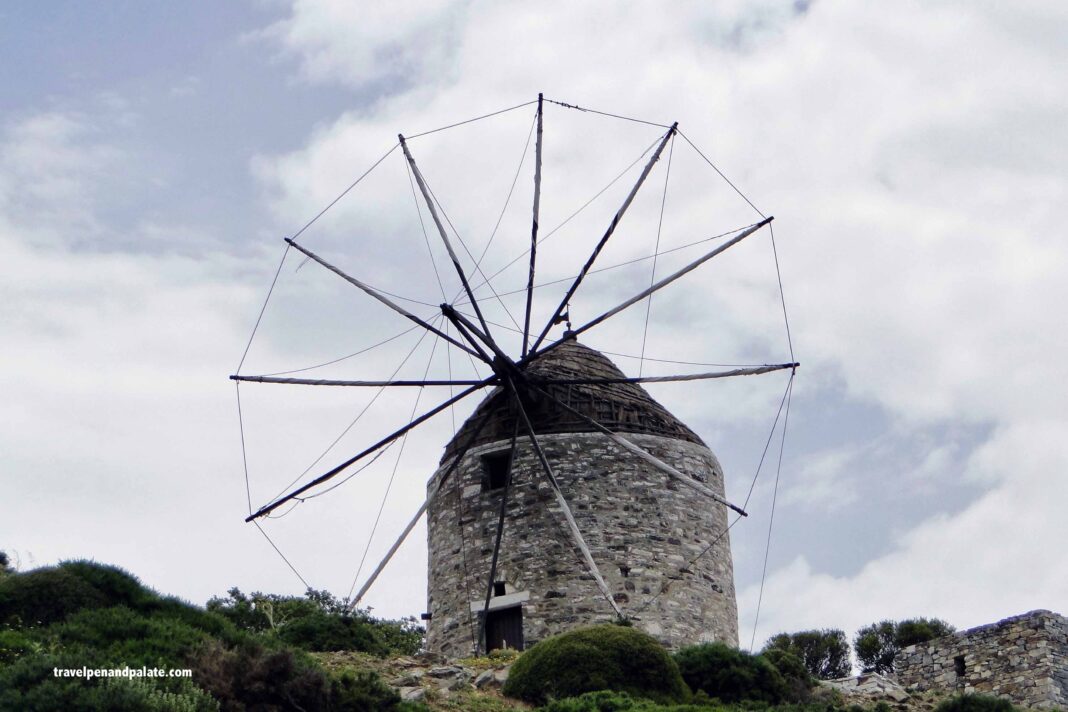Greece’s long and turbulent civilization lay scattered throughout the country. It’s as easy to stumble across millenniums old remnants of everyday life in the middle of a farm field as visit a list of top ten antiquities. Travel is very personal, and it’s the unexpected that memory embeds.
Since I write on cultural and culinary travel, I’m often visiting the world’s iconic destinations. I have access that few tourists enjoy. Yet personal contact with leading experts in their profession cannot tell the whole story of a civilization.
Ordinary people are responsible for all of history. They build, cook, run the shops and create the next generation’s heirlooms. As often as possible I take time to explore on my own, to take a road unknown.
I can see the region through my eyes only and stumble upon the ancestors’ ordinary triumphs and mistakes. Some make you laugh and others gasp.
Young man with a broken leg
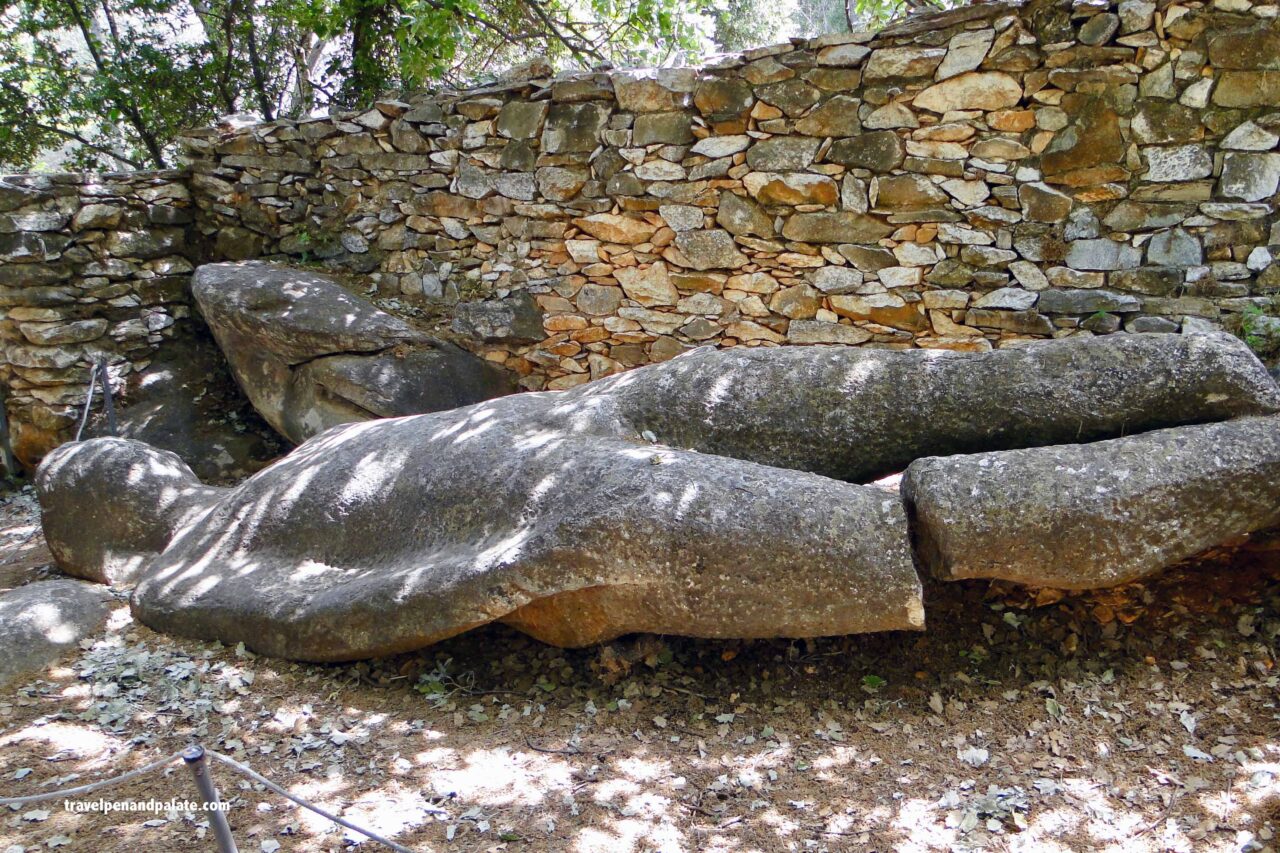
My return to the Islands of Naxos and the Small Cyclades was personal. I had my own reasons to make several return trips to Greek destinations after a long series of press assignments. For one day I used the guidance of Spyros Manolas, Naxos Sun Holidays, because I had been impressed with his knowledge during a previous press trip. I knew he’d take me off the tourist road, stopping along the way to literally and metaphorically stumble over the past.
At a tiny out of the way roadside archeological site is an important mistake, a real accident – a young man with a broken leg.
Sometime around 570 BC this unfinished 15′ (5 meter) marble statue of a young man was being moved from a “stage 1” carving workshop at a Naxos marble query to a finishing workshop some kilometers away. It fell off its moving platform and broke, I’m sure much to the chagrin of the workers.
Seems it was too much to clean up. Two thousand five hundred years later it was discovered by a local farmer. Archaeologists left it in place; today’s trash becomes tomorrow’s treasure.
Marble is forever?
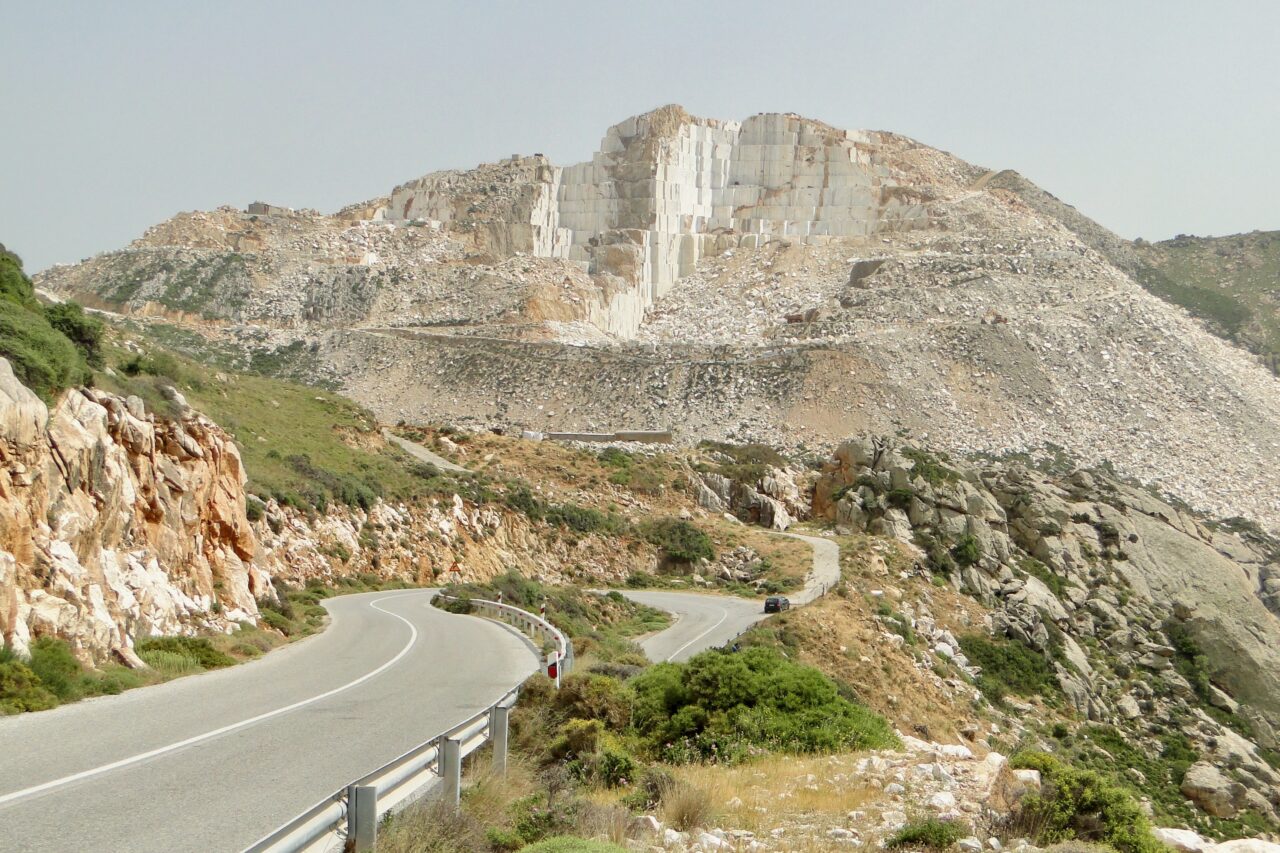
Marble and Greece have been inextricably linked since time immemorial. Naxos is a mountainous island with an abundance of building stone. It’s as if the mountain can simply be sliced.
Naxos has been a major supplier of marble, especially highly prized white marble, for over 3,000 years. The quarries, cutters and craftsmen of this fabled stone remain an integral part of the economy. Even in the 21st century marble production contributes 15% of the island’s gross domestic product.

I was given a tour of a leading Naxos factory. N. Georgakopoulos Sons – A. Sofikitis O.E. is an industry leader in cutting and marketing Naxos marble and granite. Although modern technology certainly makes the work easier, the basic process has changed little in the millenniums.
Jets of water cool the highly honed blades. The process puts less stress on the tools and helps the integrity of the stone preventing fracturing. Water has been an essential component of cutting and polishing marble since antiquity even when using hand tools.
Where gods relax
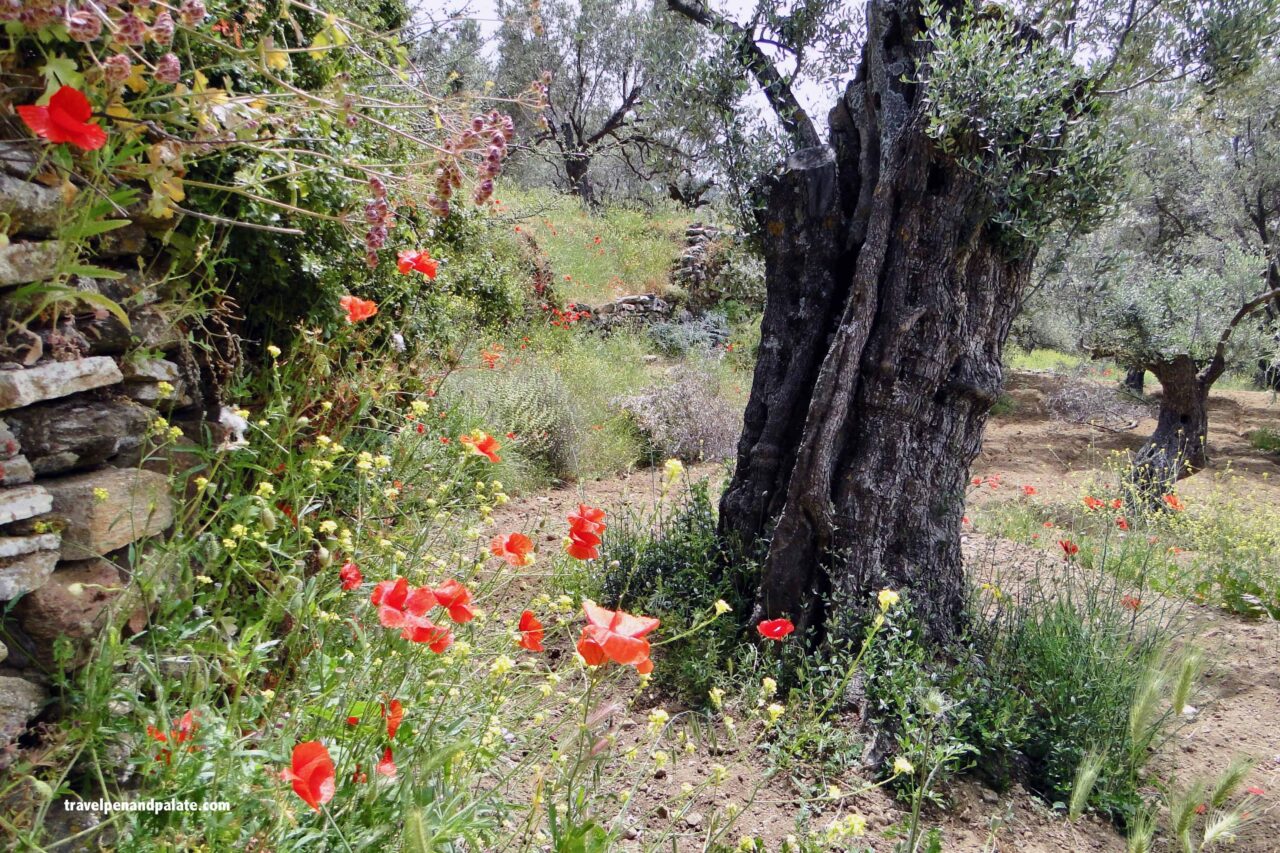
Zeus was born in a cave on Naxos. The island’s tallest mountain is named in his honor – Mount Zas. Dionysus favored the island often with his presence. Archeological sites to the pantheon dot the island from the impressive Temple of Demiter, goddess of agriculture, to the icon of the island, the Portara on Naxos Town’s harbor facing legendary Delos, the island sacred to Apollo.
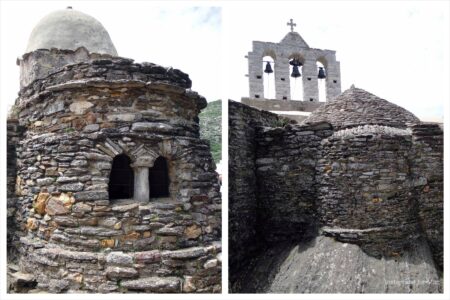
Tucked away within rural bliss is an important post-pantheon site. Yet I can imagine nymphs and gods gathering to rest during time off running the world. This imagined garden of the gods is the entrance to the Panagia Drossiani.
One of Byzantine Christianity’s oldest churches and still in use, the Panagia Drossiani exudes serenity among its 500+ year old olive trees strewn with life affirming poppy flowers. The early 6th century original melds with additions down through the 12th century. It’s essentially a complex of four architecturally different church designs in the shape of a cross.

The original 6th century church is a rare existing example of stone corbelling. The cut sections of stone gradually overlap at the top of the walls creating a self-supporting domed roof. On the opposite side of the church is the 12th century entrance and bell tower in a simple Medieval Byzantine style of stone covered with stucco. The intimate, rather dark interior is covered with some of the earliest Byzantine frescoes known in the Hellenic world.
Doors have stories

Architectural details catch my eye. Doors in particular are intriguing. They are the portal between the exterior created by nature and an inner, often unique, human world.
My mind can create a fictional script of life behind the door. The design, decoration and age can signal possible uses of the space they are guarding.
- Within the Kastro of Naxos Town, for example, simple, thick wooden doors attest to the needs of the 13th century Venetian fortress.
- A riot of colorful bougainvillea and geraniums compliment classic white stucco and blue trim in front of a family home.
- The frame of the red door on another is embedded with a section of a carved marble column dating to antiquity.
- A visitor does not stumble over the Portara, but perhaps they do over its story.
The Portara, the icon of Naxos & the Small Cyclades, is the surviving main portal of an unfinished 6th century BC temple to Apollo. It’s prominently visible by all who enter the harbor of Naxos Town. It was meant to illicit gasps.
Construction was started by the island’s then vainglorious ruler to be the region’s largest temple to the beloved Apollo and positioned so that the temple faces the sacred island of Delos. Delos is the legendary birthplace of Apollo and, to the end of the classical era, the wealthiest island in Greece. It was as well a major customer of Naxos marble and agricultural products.
War and political strife stopped construction on the Sanctuary of Delian Apollo within a few decades, and it was never completed. From the Portara are beautiful views of Naxos Town and its expansive harbor.
Naxos potatoes: New World vegetable becomes Greek
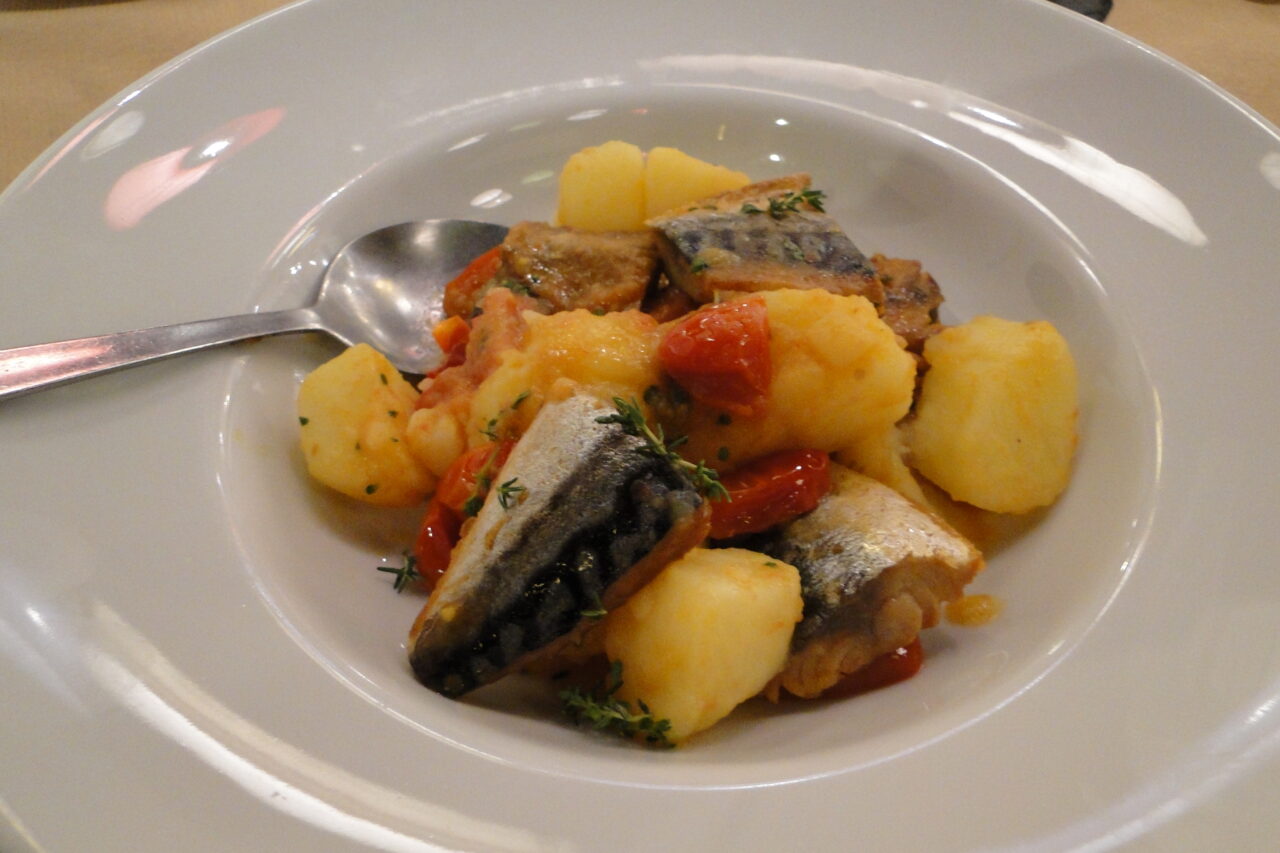
Naxos is well-known for the quality and taste of its potatoes, which are cultivated especially in the valley of Livadi. The quantities produced in the villages of the valley are such that they’re exported throughout Greece. This continues Naxos’ position since ancient days as an agricultural powerhouse.
Unlike many Cyclades Islands Naxos enjoys an ample aquifer. As the largest island with mountains as high as 3,200 feet (1K meters) Naxos has its own micro climate. Rainfall is significantly higher than the average dry island. The interior is lush and green subdivided by several valleys each ideal for fruits, grains, grapes or produce. Today agricultural production accounts for 45% of the island’s gross domestic product.
The potato has been cultivated on Naxos since the 1700s. The tuber was a New World import to Europe in the 1600s from the Andean Highlands of South America. In the Andes over 4,000 indigenous varieties of potatoes have been identified and cultivated for as long as Greece has had grapes.
Commercial cultivation of potatoes for export began in 1953 with the valley of Livadi becoming the designated area for the production of Naxos Potato seedlings that would be distributed to other areas of Greece. The small, round potato provides two harvests a year, June and December. In August it’s honored by the annual Naxos Potato Fest.
The Naxos potato is especially good in salads or oven roasted with olive oil, lemon and garlic, and a warm Naxos Potato Salad hit all my favorite Greek flavors. Meze Meze on the waterfront of seafood loving Naxos Town served steamed potatoes, steamed zucchini, capers and an abundance of marinated fresh anchovies in a light creamy mustard sauce. It was a satisfying discovery after tripping over Naxos all day.
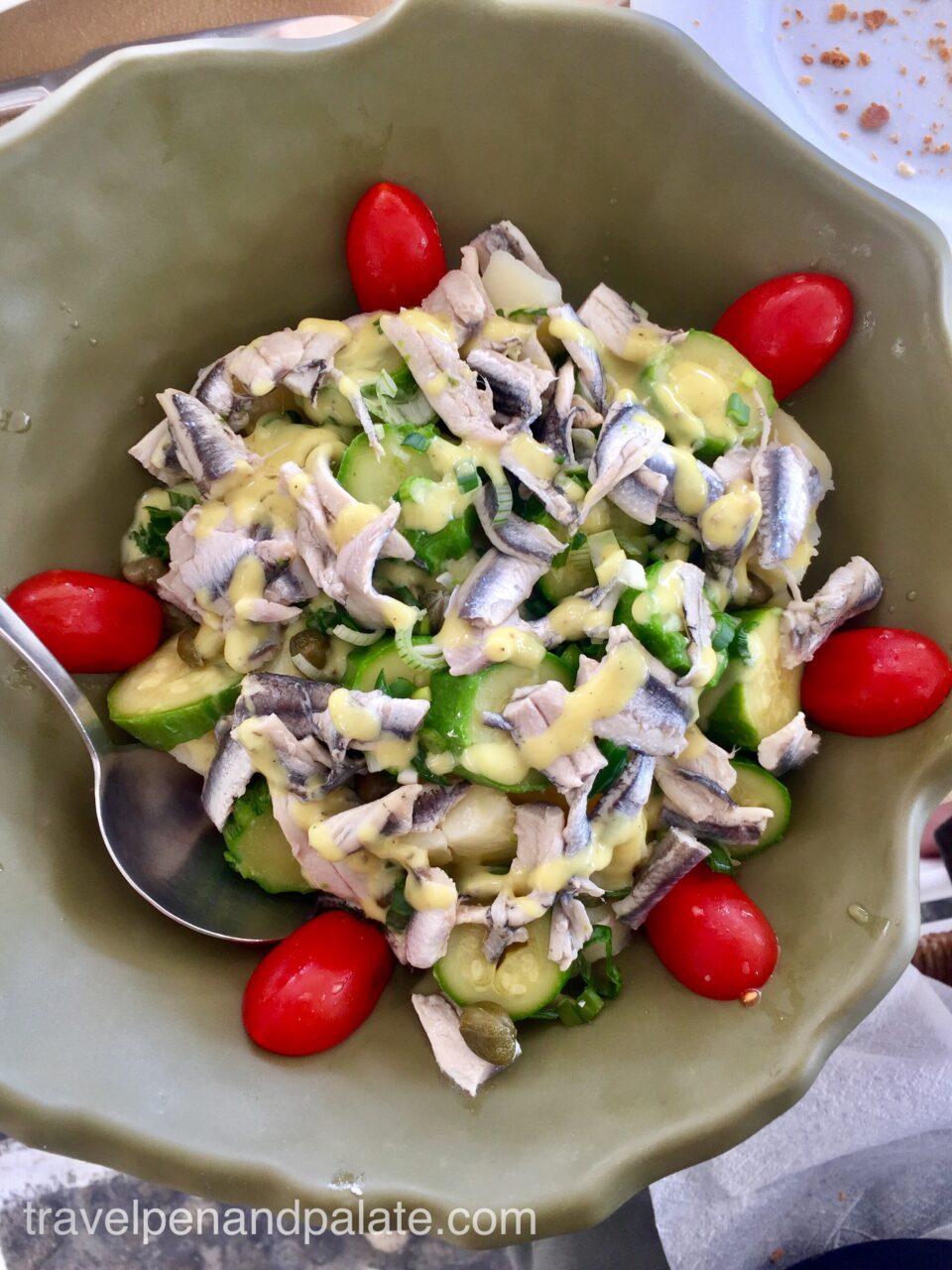
When you go: Naxos is easily reached by air through Athens or by ferry service from Pireaus (port for Athens) and Rafina. I recommend the comfortable ships of Blue Star Ferries.
You can read more on Naxos and the Small Cyclades with information on hotels, restaurants and things to do at:
Naxos, Mykonos, Delos: divine vacations in the Cyclades
The harvest of Naxos and the Small Cyclades
Celebrate at the home of Carnival: Naxos and the Small Cyclades
Travel with Pen and Palate every month to Greece and the world in the Hellenic News of America.




